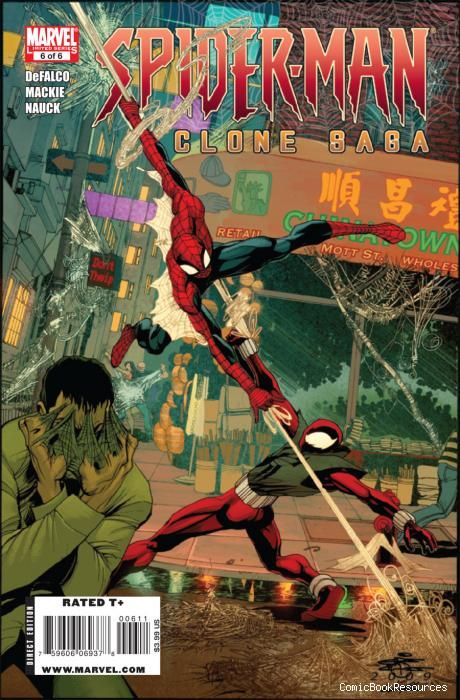The original Spider-Clone Saga lasted just over two years, spread across the four monthly Spider-Man titles, various mini-series, one-shots, and some issues of "Spider-Man Unlimited," whereas this 'proper' rewriting/retelling only received six issues. While the first one was horribly drawn out and lasted much too long, "Spider-Man: The Clone Saga" has been very compressed, reading like a comic story on fast forward much of the time. This final issue escapes that trap by playing out as a regular conclusion to a story, though it still has many problems, including a rushed, underexplained final scene.
The issue begins with Ben Reilly, who has taken up the mantle of Spider-Man, prisoner of the Green Goblin, which shouldn't be since both Norman and Harry Osborn are dead. However, this Goblin is revealed as none other than Harry Osborn after he faked his death and has been responsible for the events of the previous five issues, including the kidnapping of Peter and Mary Jane's newborn daughter. His goal is to take away everything from Peter, to destroy his family as he thinks Peter destroyed his. This is a rather big divergence from the original Clone Saga and is about as logical as the return of Norman Osborn there. If anything, the use of Harry here comes off as a swerve for anyone expecting the mastermind to be Norman.
However, DeFalco and Mackie do get some mileage out of the switch by also introducing a clone of Norman as Kaine fills him in on what has happened since his death back in "Amazing Spider-Man" #122, while also subtly influencing the cloned Norman's perspective on Harry's actions. Things culminate in a fight between Harry, the two Spider-Men, and his cloned father in an easy to predict manner, but still satisfying. Where the issue falls apart is the final scene which seeks to resolve the role of Ben in the Spider-Man universe, but doesn't accomplish much of anything.
Todd Nauck's art throughout the series has been overly busy and messy because of the compressed nature of the story and the need to fill pages with as much content as possible. This issue is no exception, but the messiness of his lines matches the harsh and violent nature of the final fight. Those dark, messy inks don't work for the quieter emotional scenes with Aunt May and Mary Jane, but for the knock down brawl between the Goblins and Spider-Men, the energy displayed in his lines push the comic forward well. His art also captures the visual style of the mid-'90s when the original Clone Saga happened and acts as a nice touch there.
While not as satisfying as the concept claimed, "Spider-Man: The Clone Saga" has acted as a nice trip down memory lane (albeit in an altered form) by revising Ben Reilly, Kaine, and the other elements of the original Clone Saga. The final issue delivers a new, different overarching plot explanation and doesn't end completely satisfying, but it is an interesting issue full of action.

